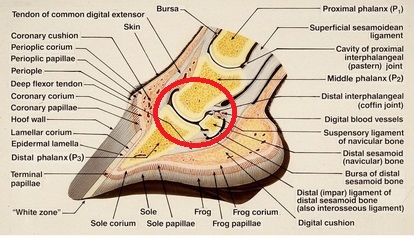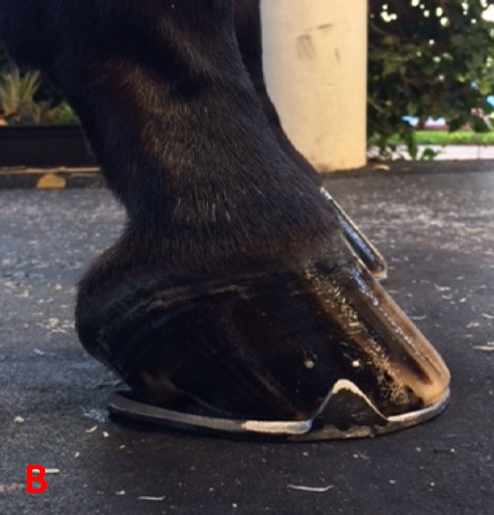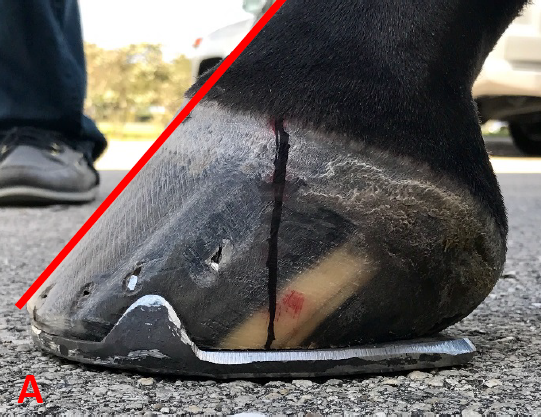The importance of good quality hoof care in the competition horse can't be denied. The equine hoof is unique as it is comprised of a group of biological structures that follow the laws of biomechanics (Figure 1). Your farrier is a major asset during the show season in Wellington as he or she can be proactive in keeping your horse's feet healthy and thus preventing lameness. There are three very important aspects of farriery that the farrier will use to keep your horse sound which are trimming the foot along with the size and placement of the horseshoe. The farriery session will begin with an evaluation of the conformation of each hoof from the front, side and from behind (to observe the height of the heels). Next the farrier should observe the horse in motion to see whether the horse's foot lands heel first, flat or toe first. All this information is considered before the farriery begins.
 |
| Fig 1. Illustration shows the biological structures of the hoof and the biomechanical focus(red circle) |
Regarding the trim, many farriers no longer use the term 'balance the foot' - which has no meaning - and have begun to use guidelines or landmarks when approaching the trim. The guidelines used are trimming to achieve a straight hoof-pastern axis, using the widest part of the foot which correlates to the center of rotation and trimming the palmar foot (heels) to the base of the frog or to the same plane as the frog (Figure 2, 3). A closer look at these three guidelines, which are all interrelated, will help to show their importance. If the dorsal (front) surface of the pastern and the dorsal surface of the hoof are parallel or form a straight line, then the bones of the digit (P1, P2, P3 ) are in a straight line and the force from the weight of the horse will go through the middle of the joint. Furthermore and equally important, if the hoof-pastern axis is straight, the weight will be distributed evenly on the bottom of the foot. The second guideline is the center of rotation (COR)...and as the COR is located a few millimeters behind the widest part of each foot, it allows the farrier to apply appropriate biomechanics to each foot...the foot is trimmed in approximate proportions on either side of the widest part of the foot which provides biomechanical efficiency.
 |
| Fig 2. Yellow dotted line shows the bony alignment of the digit. Red line shows the straight hoof- pastern axis |
 |
| Fig 3. Black line is the widest part of the foot and the yellow dotted line shows the heels trimmed to the base of the frog |
Lastly, one should trim the palmar section of the foot to the base of the frog or trim such that the heels of the hoof capsule and the frog are on the same plane. Adherence to this guideline keeps the soft tissue structures (frog, digital cushion, ungula cartilages) within the hoof capsule which are necessary to absorb concussion and dissipate the energy of impact. We must remember that heels do not grow tall, they grow forward. If we allow the heels to migrate forward, the soft tissue structures will be forced backward out of the hoof capsule. Furthermore, as the heels migrate forward, the ground surface of the foot is decreased and the weight is transferred to the lamellae and bone thus bypassing the soft tissue structures of the foot. An example of this guideline is shown in Figures 4A & 4B where the palmar foot was trimmed appropriately and a size larger shoe was applied.
 |  |
| Fig 4A Foot where heels have migrated forward and red circle shows the soft tissue structures displaced out of the hoof capsule and thickened | Fig 4B Shows the same foot after the heel have been trimmed and a larger shoe has been applied |
These three guidelines can be applied to any foot and they serve as a basis for maintaining a healthy foot and a basic starting point for applying farriery to a horse with poor foot conformation or one with a distorted hoof capsule. Figures 5A & 5B will illustrate a hoof where all three of these guidelines have been applied.
 |
| Fig 5A Foot shows the 3 guidelines applied to the foot. Note the proportions on either side of the widest part (black line) of the foot |
 |
| Fig 5B Shows the length of the shoe and the wide expanse of the shoe creating a platform under the foot |
A parting thought from my observations. Many horses are given a rest from competition which includes their feet prior to leaving for Wellington. Many arrive with very reasonable foot conformation but upon arrival the farriery often changes and many horses are shod with various specialty shoes, wedges, pads, pour-ins, etc. as a means of protection and perhaps to enhance their performance. As the season progresses and the work load increases, the sole thickness starts to decrease and the feet become softer from multiple baths; now the farriery that was applied for protection may be causing pressure on the thinner, softer structures of the foot, thus becoming somewhat detrimental. Furthermore, the horses continue to be trimmed and shod on a monthly basis and the farrier may not be aware of the change in the integrity of the hoof structures and so perhaps some horses are over trimmed. As the season starts into March, the structures of the foot deteriorate further as a result of the work load and many horses begin to become foot sore. At this point the farrier options become limited because they were all used at the beginning of the season. I remember the words of my early mentor, Joe Pierce, when I was learning the farrier trade a long time ago: "no one will know if you leave the last few rubs of the rasp on the foot but everyone will know if you take a few too many rubs'!
Palm Beach Equine Clinic offers a farriery consultation service to both veterinarians and farriers. This unique service provides a second opinion or 'another set of eyes' to both professions when treating difficult farriery cases.